Lenses and Optics
Variance Measurement for 35mm SLR Lenses
Last week we posted optical bench MTF and copy-to-copy variation measurements for 50mm SLR lenses. We’re going to continue that series this week with the same measurements for the 35mm lenses. This set should fill out the wide-to-standard range lenses and gives us a lot of interesting data as we continue to look at what factors affect copy-to-copy variation. These lenses range in price from $200 to $2300 USD, includes a couple of lenses first released in the 1990s and several released in the last couple of years, complexity ranging from 4 to 10 groups with and without aspheric elements.
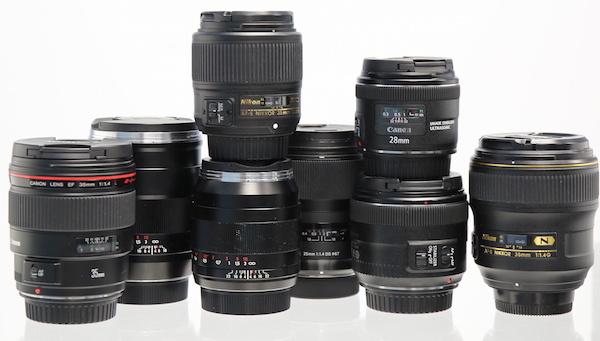
MTF Curves of the 35mm Lenses
Ten copies of each lens were tested on our Trioptics Imagemaster Optical Bench using the standard protocol, which we described in the introductory blog post. All lenses are tested at their widest apertures, so take that into consideration when comparing MTFs; stopping an f/1.4 lens down to f/1.8 or f/2.0 would improve its MTF. (And yes, I realize how nice it would be to have done the f/1.4 lenses at f/1.8 and f/2.0. I might get to it someday. Maybe.)
Let’s take a look at the MTF curves for the 35mm lenses. Below are the average curves for each lens. They are in no particular order of anything other than kind of trying to keep lenses of the same brand together.
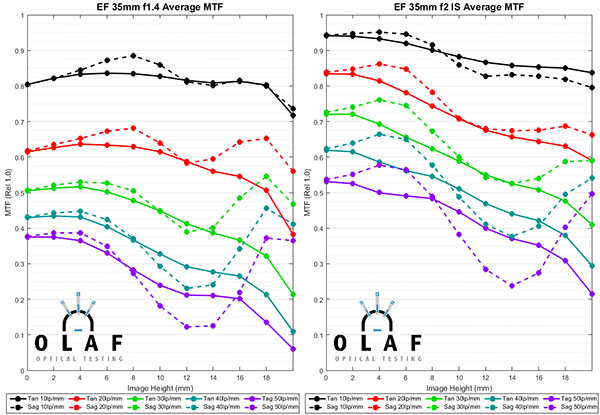
- Roger Cicala and Brandon Dube, Lensrentals.com, 2015
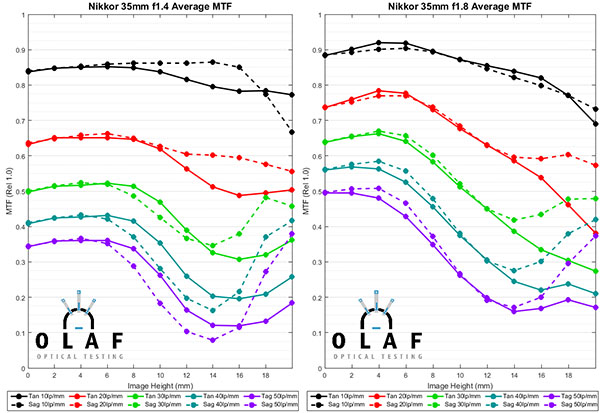
- Roger Cicala and Brandon Dube, Lensrentals.com, 2015
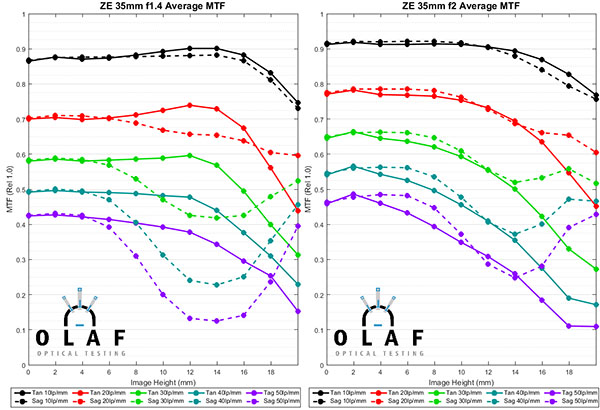
- Roger Cicala and Brandon Dube, Lensrentals.com, 2015
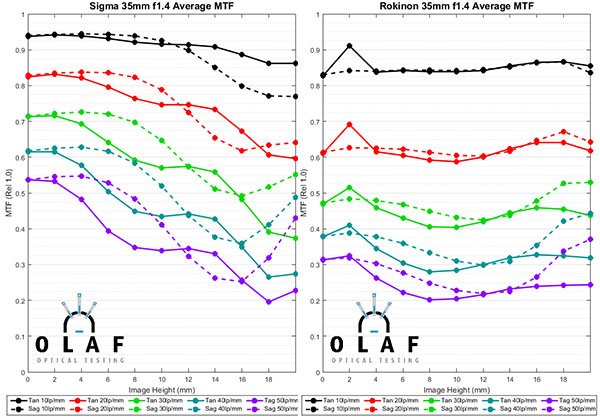
- Roger Cicala and Brandon Dube, Lensrentals.com, 2015
The MTF curves for the f/1.4 lenses don’t show us much that we didn’t already know. The Sigma 35mm f/1.4 Art lens has the best resolution of the bunch. The Zeiss 35mm f/1.4 isn’t quite as sharp, but clearly is the second best. The Rokinon 35mm f/1.4 is very comparable to the name-brand glass and interesting in that it maintains excellent resolution all the way to the edges. The Rokinon 35mm has a tangential ‘bump’ at 2mm, like the Rokinon 50mm lens did. Again, this is an artifact of local distortion from the aspheric element that affects our testing, but would not affect your shooting.
If there’s a takeaway message from the MTF curves, it’s that if you don’t absolutely need to shoot at f/1.4, you can save quite a bit of money by grabbing the Canon 35mm f/2, Zeiss 35mm f/2, or Nikon 35mm f/1.8 G AF-S lenses. They’re all excellent. If you do need to shoot at f/1.4 and want the highest resolution possible, then you want the Sigma 35mm f/1.4. Note that I didn’t say the best lens, I said best resolution. There is more to the choice of a 35mm lens than simply resolution, but it’s always good to know what kind of resolution you are going to get.
Speaking of what you’re going to get, let’s take a look at how much copy-to-copy variation we can expect from these lenses.
Copy-to-Copy Variation
The simplest way to look at variation is with our Consistency number (for a complete discussion of how we arrive at the Consistency number, see this post). In summary, a higher consistency number means there is less copy-to-copy variation; the lens you buy is more likely to closely resemble the MTF average we presented above. In general, a score over 7 is excellent, a score from 6-7 good, 5-6 okay, 4-5 is a going to have significant copy-to-copy variation, and under 4 is a total crapshoot.
Here are the variation graphs for the 35mm lenses in the same order as we presented the MTFs above. The consistency number is in bold at the lower left of each graph.
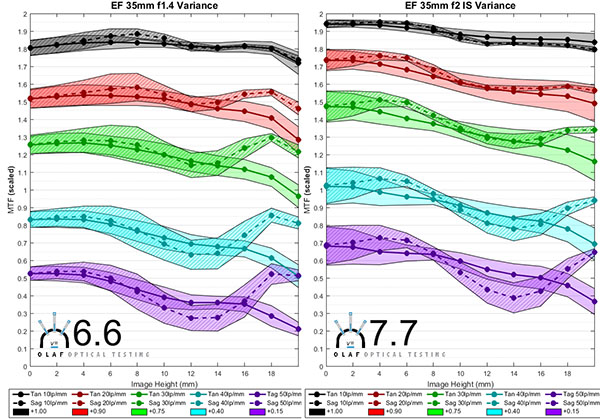
Roger Cicala and Brandon Dube, Lensrentals.com, 2015
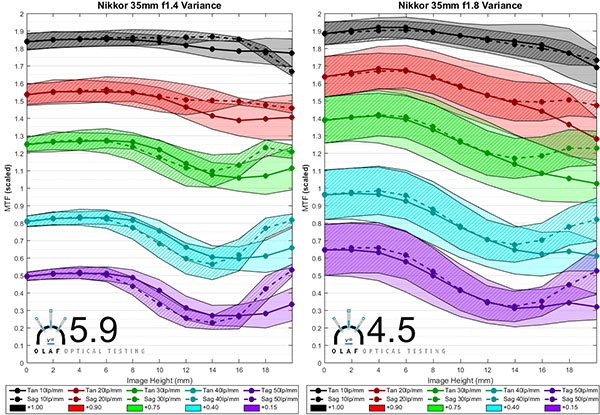
Roger Cicala and Brandon Dube, Lensrentals.com, 2015
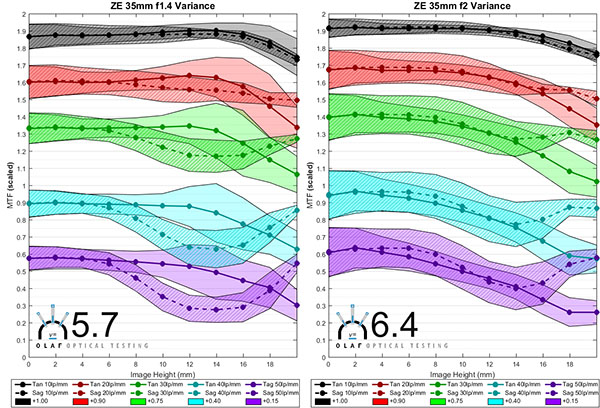
Roger Cicala and Brandon Dube, Lensrentals.com, 2015
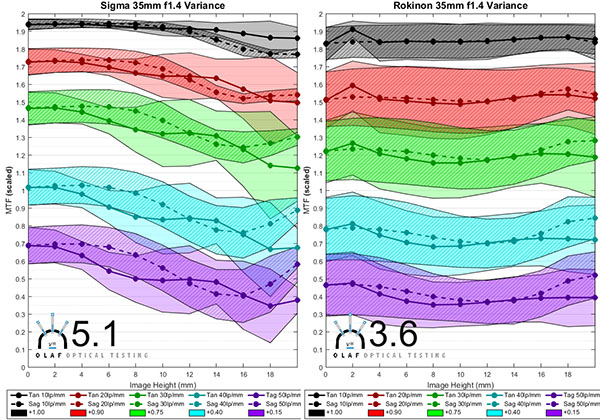
Roger Cicala and Brandon Dube, Lensrentals.com, 2015
The Consistency numbers for the 35mm lenses were generally poor, generally no better than the 24mm lenses. The two Canon lenses and the Zeiss 35mm f/2 all were above 6, and the Nikon and Zeiss 35mm f/1.4 lenses weren’t far behind. For the Nikon 35mm f/1.4 and Zeiss 35mm f/1.4 lenses particularly, the Consistency number doesn’t give as much information as the actual variation graph. If you look at the graph you’ll notice they are quite consistent in the center. Their variance comes in the outer 1/3 if the lens. This suggests thy will be quite consistent as far as center sharpness, but copies tend to suffer from a soft corner or soft side.
The other lenses had lower consistency. I was quite surprised at the Nikon 35mm f/1.8; the Nikon 50mm f/1.8 showed a lot less variation and I had expected similar performance with the 35mm f/1.8. Also, if you look at the actual graphs you’ll note that the Rokinon and Nikon 35mmf /1.8 tended to vary a lot at the center of the lens, meaning the variation here is affecting center sharpness, not just creating soft corners.
There’s not a lot of trending with the 35mm lenses. The Canon 35mm f/1.4 and Zeiss 35mm f/2 are two of the oldest designs, yet they also have good consistency scores, but the very best consistency score comes from the newer Canon 35mm f/2. The more expensive lenses (Canon 35mm f/1.4, Zeiss 35mm f/1.4, and Nikon 35mm f/1.4 G have good Consistency scores but it’s not something that seems significant. However, the inexpensive Rokinon 35mm f/1.4 and Nikon 35mm f/1.8 AF-S G do have the lowest Consistency scores.
I won’t repeat the trendspotting graphs we placed in the last post. You can look back at it and see the 35mm lenses were already mapped out on the variation-by-focal-length graph, just not labeled. We’ll put up the ultra-wide angle and short telephoto lens results in the next week and then follow with a summary ‘trendspotting’ article when we have all of our prime lens data to look at.
Roger Cicala and Brandon Dube
Lensrentals.com
July, 2015
Author: Roger Cicala
I’m Roger and I am the founder of Lensrentals.com. Hailed as one of the optic nerds here, I enjoy shooting collimated light through 30X microscope objectives in my spare time. When I do take real pictures I like using something different: a Medium format, or Pentax K1, or a Sony RX1R.
-
Andrew
-
derek
-
AJ
-
John Mc
-
JK
-
AJ
-
Samuel H
-
Keith
-
L.P.O.
-
AJ
-
Lee Saxon
-
Aaron
-
A
